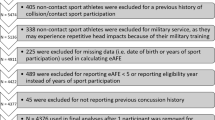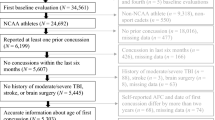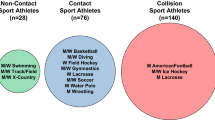Abstract
Background
Collegiate football players who started playing tackle football before age 12 years did not show worse neuropsychological test performance than those who started playing tackle football after age 12 years. It is unknown if beginning other contact sports, such as lacrosse, at a younger age is associated with worse neurocognitive performance, greater psychological distress, or worse postural stability in collegiate student athletes.
Objective
The purpose of this study was to examine the association between estimated age of first exposure (eAFE) to repetitive head impacts (RHI) and these outcome measures in collegiate student athletes.
Methods
1891 female and 4448 male collision/contact (i.e., football, ice hockey, lacrosse, wrestling, soccer) and non-contact (i.e., golf, rifle, rowing/crew, swimming, tennis) sport athletes completed baseline testing, including the Immediate Post-Concussion Assessment and Cognitive Testing (ImPACT), Brief Symptom Inventory 18 (BSI-18), and Balance Error Scoring System (BESS).
Results
For women, the eAFE-by-sport interaction was associated with ImPACT Verbal Memory and Visual Memory, whereby earlier eAFE to contact sports was associated with higher composite scores (B = − 0.397, B = − 0.485, respectively). For men, the eAFE-by-sport interaction was associated with BSI-18 Depression and Global Severity Index and symptom severity scores, whereby earlier eAFE to football was associated with lower psychological distress and symptom severity [Depression, Exp(B) = 1.057; Global Severity Index, Exp(B) = 1.047; Symptom Severity, Exp(B) = 1.046]. Parameter estimates were small suggesting these results may have minimal practical relevance.
Conclusion
Findings suggest that RHI during early adolescence is unrelated to brain health as measured by these specific outcome measures in collegiate student athletes.


Similar content being viewed by others
Data availability statement
The CARE Consortium datasets generated and analyzed during the current study are available in the FITBIR repository (https://fitbir.nih.gov/).
References
Lebel C, Walker L, Leemans A, Phillips L, Beaulieu C. Microstructural maturation of the human brain from childhood to adulthood. Neuroimage. 2008;40(3):1044–55.
Blakemore S, Choudhury S. Development of the adolescent brain: implications for executive function and social cognition. J Child Psychol Psychiatry. 2006;47(3–4):296–312.
Snook L, Paulson L, Roy D, Phillips L, Beaulieu C. Diffusion tensor imaging of neurodevelopment in children and young adults. Neuroimage. 2005;26(4):1164–73.
Courchesne E, Chisum HJ, Townsend J, Cowles A, Covington J, Egaas B, et al. Normal brain development and aging: quantitative analysis at in vivo MR imaging in healthy volunteers. Radiology. 2000;216(3):672–82.
Shaw P, Kabani NJ, Lerch JP, Eckstrand K, Lenroot R, Gogtay N, et al. Neurodevelopmental trajectories of the human cerebral cortex. J Neurosci. 2008;28(14):3586–94.
Stamm JM, Koerte IK, Muehlmann M, Pasternak O, Bourlas AP, Baugh CM, et al. Age at first exposure to football is associated with altered corpus callosum white matter microstructure in former professional football players. J Neurotrauma. 2015;32(22):1768–76.
Schultz V, Stern RA, Tripodis Y, Stamm J, Wrobel P, Lepage C, et al. Age at first exposure to repetitive head impacts is associated with smaller thalamic volumes in former professional American football players. J Neurotrauma. 2018;35(2):278–85.
Alosco ML, Kasimis AB, Stamm JM, Chua AS, Baugh CM, Daneshvar DH, et al. Age of first exposure to American football and long-term neuropsychiatric and cognitive outcomes. Transl Psychiatry. 2017;7(9):e1236.
Stamm JM, Bourlas AP, Baugh CM, Fritts NG, Daneshvar DH, Martin BM, et al. Age of first exposure to football and later-life cognitive impairment in former NFL players. Neurology. 2015;84(11):1114–20.
Alosco ML, Mez J, Tripodis Y, Kiernan PT, Abdolmohammadi B, Murphy L, et al. Age of first exposure to tackle football and chronic traumatic encephalopathy. Ann Neurol. 2018;83(5):886–901.
Solomon GS, Kuhn AW, Zuckerman SL, Casson IR, Viano DC, Lovell MR, et al. Participation in Pre-High school football and neurological, neuroradiological, and neuropsychological findings in later life: a study of 45 retired National Football League players. Am J Sports Med. 2016;44(5):1106–15.
Casson IR, Viano DC, Haacke EM, Kou Z, LeStrange DG. Is there chronic brain damage in retired NFL players? neuroradiology, neuropsychology, and neurology examinations of 45 retired players. Sports Health. 2014;6(5):384–95.
Roberts AL, Pascual-Leone A, Speizer FE, Zafonte RD, Baggish AL, Taylor Jr H, et al. Exposure to American football and neuropsychiatric health in former National Football League players: findings from the football players health study. Am J Sports Med. 2019. (epub ahead of print).
Montenigro PH, Alosco ML, Martin BM, Daneshvar DH, Mez J, Chaisson CE, et al. Cumulative head impact exposure predicts later-life depression, apathy, executive dysfunction, and cognitive impairment in former high school and college football players. J Neurotrauma. 2017;34(2):328–40.
Caccese JB, DeWolf RM, Kaminski TW, Broglio SP, McAllister TW, McCrea M, et al. Estimated age of first exposure to american football and neurocognitive performance amongst NCAA male student-athletes: a cohort study. Sports Med. 2019;49(3):477–87.
Brett BL, Huber DL, Wild A, Nelson LD, McCrea MA. Age of first exposure to American football and behavioral, cognitive, psychological, and physical outcomes in high school and collegiate football players. Sports Health. 2019. (epub ahead of print).
Caccese JB, Iverson GL, Cameron K, Houston MN, McGinty J, Jackson JC, et al. Estimated age of first exposure to contact sports is not associated with greater symptoms or worse cognitive functioning in US service academy athletes. J Neurotrauma. 2019. (epub ahead of print).
Houck Z, Asken B, Clugston J, Perlstein W, Bauer R. Socioeconomic status and race outperform concussion history and sport participation in predicting collegiate athlete baseline neurocognitive scores. J Int Neuropsychol Soc. 2018;24(1):1–10.
Houck ZM, Asken BM, Bauer RM, Caccese JB, Buckley TA, McCrea MA, et al. Academic aptitude mediates the relationship between socioeconomic status and race in predicting ImPACT scores in college athletes. Clin Neuropsychol. 2019. (epub ahead of print).
Daniel RW, Rowson S, Duma SM. Head impact exposure in youth football. Ann Biomed Eng. 2012;40(4):976–81.
Cobb BR, Urban JE, Davenport EM, Rowson S, Duma SM, Maldjian JA, et al. Head impact exposure in youth football: elementary school ages 9–12 years and the effect of practice structure. Ann Biomed Eng. 2013;41(12):2463–73.
Mihalik JP, Guskiewicz KM, Marshall SW, Blackburn JT, Cantu RC, Greenwald RM. Head impact biomechanics in youth hockey: comparisons across playing position, event types, and impact locations. Ann Biomed Eng. 2012;40(1):141–9.
Reed N, Taha T, Keightley M, Duggan C, McAuliffe J, Cubos J, et al. Measurement of head impacts in youth ice hockey players. Int J Sports Med. 2010;31(11):826–33.
Chrisman SP, Mac Donald CL, Friedman S, Andre J, Rowhani-Rahbar A, Drescher S, et al. Head impact exposure during a weekend youth soccer tournament. J Child Neurol. 2016;31(8):971–8.
Hanlon EM, Bir CA. Real-time head acceleration measurement in girls’ youth soccer. Med Sci Sports Exerc. 2012;44(6):1102–8.
Broglio SP, McCrea M, McAllister T, Harezlak J, Katz B, Hack D, et al. A national study on the effects of concussion in collegiate athletes and US military service academy members: the NCAA–DoD concussion assessment, research and education (CARE) consortium structure and methods. Sports Med. 2017;47(7):1437–51.
Katz BP, Kudela M, Harezlak J, McCrea M, McAllister T, Broglio SP, et al. Baseline performance of NCAA athletes on a concussion assessment battery: a report from the CARE consortium. Sports Med. 2018;48(8):1971–85.
Broglio SP, Katz BP, Zhao S, McCrea M, McAllister T, CARE Consortium Investigators. Test–retest reliability and interpretation of common concussion assessment tools: Findings from the NCAA–DoD CARE consortium. Sports Med. 2017;48(5):1255–68.
Meachen S, Hanks RA, Millis SR, Rapport LJ. The reliability and validity of the brief symptom inventory-18 in persons with traumatic brain injury. Arch Phys Med Rehabil. 2008;89(5):958–65.
Kelly KC, Jordan EM, Joyner AB, Burdette GT, Buckley TA. National collegiate athletic association division I athletic trainers’ concussion-management practice patterns. J Athl Train. 2014;49(5):665–73.
Buckley TA, Burdette G, Kelly K. Concussion-management practice patterns of National Collegiate Athletic Association division II and III athletic trainers: how the other half lives. J Athl Train. 2015;50(8):879–88.
Schatz P, Pardini JE, Lovell MR, Collins MW, Podell K. Sensitivity and specificity of the ImPACT test battery for concussion in athletes. Arch Clin Neuropsychol. 2006;21(1):91–9.
Broglio SP, Katz BP, Zhao S, McCrea M, McAllister T, CARE Consortium Investigators. Test–retest reliability and interpretation of common concussion assessment tools: findings from the NCAA–DoD CARE consortium. Sports Med. 2018;48(5):1255–68.
Buckley TA, Oldham JR, Caccese JB. Postural control deficits identify lingering post-concussion neurological deficits. J Sport Health Sci. 2016;5(1):61–9.
Finnoff JT, Peterson VJ, Hollman JH, Smith J. Intrarater and interrater reliability of the balance error scoring system (BESS). PM&R. 2009;1(1):50–4.
Hollingshead AD. Four factor index of social status. New Haven, CT: Yale University; 1975. https://sociology.yale.edu/sites/default/files/files/yjs_fall_2011.pdf#page=21
Brooks BL, Silverberg N, Maxwell B, Mannix R, Zafonte R, Berkner PD, et al. Investigating effects of sex differences and prior concussions on symptom reporting and cognition among adolescent soccer players. Am J Sports Med. 2018;46(4):961–8.
Alosco ML, Stern RA. Youth exposure to repetitive head impacts from tackle football and long-term neurologic outcomes: a review of the literature, knowledge gaps and future directions, and societal and clinical implications. Semin Pediatr Neurol. 2019. (epub ahead of print).
Janssen PH, Mandrekar J, Mielke MM, Ahlskog JE, Boeve BF, Josephs K, Savica R. High school football and late-life risk of neurodegenerative syndromes, 1956–1970. Mayo Clin Proc. 2017;92(1):66–71).
Savica R, Parisi JE, Wold LE, Josephs KA, Ahlskog JE. High school football and risk of neurodegeneration: a community-based study. Mayo Clin Proc. 2012;87(4):335–40.
Deshpande SK, Hasegawa RB, Rabinowitz AR, Whyte J, Roan CL, Tabatabaei A, et al. Association of playing high school football with cognition and mental health later in life. JAMA Neurol. 2017;74(8):909–18.
Schmidt JD, Terry DP, Ko J, Newell KM, Miller LS. Balance regularity among former high school football players with or without a history of concussion. J Athl Train. 2018;53(2):109–14.
Manly JJ. Advantages and disadvantages of separate norms for African Americans. Clin Neuropsychol. 2005;19(2):270–5.
Kontos AP, Elbin RJ III, Covassin T, Larson E. Exploring differences in computerized neurocognitive concussion testing between African American and white athletes. Arch Clin Neuropsychol. 2010;25(8):734–44.
Broglio SP, Kontos AP, Levin H, Schneider K, Wilde EA, Cantu RC, et al. The National Institute of Neurological Disorders and Stroke and Department of Defense Sport-Related Concussion Common Data Elements version 1.0 recommendations. J Neurotrauma. 2018;35(23):2776–83.
Stone AA, Bachrach CA, Jobe JB, Kurtzman HS, Cain VS. The science of self-report: implications for research and practice. London: Psychology Press; 1999.
Acknowledgements
This publication was made possible, in part, with support from the Grand Alliance CARE Consortium, funded by the NCAA and the DoD. The USAMRAA, Ford Detrick, MD, USA, is the awarding and administering acquisition office. This work was supported by the Office of the Assistant Secretary of Defense for Health Affairs through the Psychological Health and Traumatic Brain Injury Program under Award no. W81XWH-14-2-0151. Opinions, interpretations, conclusions and recommendations are those of the authors and are not necessarily endorsed by the DoD (DHP funds).
Contributing CARE Consortium investigators include: Justus D. Ortega, PhD (Humboldt State University); Nicholas Port, PhD (Indiana University); Joshua T. Goldman, MD, MBA and Christopher C. Giza, MD (University of California, Los Angeles); Holly J. Benjamin MD (University of Chicago); James R. Clugston, MD, MS (University of Florida); Luis A. Feigenbaum, DPT, ATC (University of Miami); James T. Eckner, MD, MS (University of Michigan); Jason P. Mihalik, PhD, CAT(C), ATC (University of North Carolina at Chapel Hill); Christina L. Master, MD (University of Pennsylvania); Anthony P. Kontos, PhD (University of Pittsburgh Medical Center); Jonathan Jackson, MD (United States Air Force Academy); Adam Susmarski, DO (United States Naval Academy); Stefan Duma, PhD (Virginia Tech); Christopher M. Miles, MD (Wake Forest University); Laura Lintner DO (Winston-Salem University).
Author information
Authors and Affiliations
Consortia
Corresponding author
Ethics declarations
Funding
This publication was made possible, in part, with support from the Grand Alliance CARE Consortium, funded by the NCAA and the DoD. The USAMRAA, Ford Detrick, MD, USA, is the awarding and administering acquisition office. This work was supported by the Office of the Assistant Secretary of Defense for Health Affairs through the Psychological Health and Traumatic Brain Injury Program under Award no. W81XWH-14-2-0151. Opinions, interpretations, conclusions and recommendations are those of the authors and are not necessarily endorsed by the DoD (DHP funds).
Conflict of interest
Grant L. Iverson serves as a scientific advisor for BioDirection, Inc., Sway Operations, LLC, and Highmark, Inc. He has a consulting practice in forensic neuropsychology, including expert testimony. He has received research funding from several test publishing companies, including ImPACT Applications, Inc., CNS Vital Signs, and Psychological Assessment Resources (PAR, Inc.). He has received research funding as a principal investigator from the National Football League, and salary support as a collaborator from the Harvard Integrated Program to Protect and Improve the Health of National Football League Players Association Members. He acknowledges unrestricted philanthropic support from ImPACT Applications, Inc., the Heinz Family Foundation, the Boston Bolts, the Mooney-Reed Charitable Foundation, and the Spaulding Research Institute. Jaclyn B. Caccese, Barry Bodt, Thomas W. Kaminski, Kelsey Bryk, Jessie Oldhamn, Steven P. Broglio, Thomas W. McAllister, Michael McCrea, and Thomas A. Buckley declare that they have no additional conflicts of interest to disclose.
Research involving human participants
The study was performed in accordance with the standards of ethics outlined in the Declaration of Helsinki.
Informed consent
All study procedures were reviewed and approved by the University of Michigan IRB, the US Army Medical Research and Materiel Command Human Research Protection Office (HRPO), as well the local IRB at each of the performance sites. Participants provided written informed consent prior to participation.
Additional information
The members of CARE Consortium Investigators are listed in Acknowledgements section.
This article is part of a Topical Collection on The NCAA-DoD Concussion Assessment, Research and Education (CARE) Consortium.
Rights and permissions
About this article
Cite this article
Caccese, J.B., Bodt, B.A., Iverson, G.L. et al. Estimated Age of First Exposure to Contact Sports and Neurocognitive, Psychological, and Physical Outcomes in Healthy NCAA Collegiate Athletes: A Cohort Study. Sports Med 50, 1377–1392 (2020). https://doi.org/10.1007/s40279-020-01261-4
Published:
Issue Date:
DOI: https://doi.org/10.1007/s40279-020-01261-4




